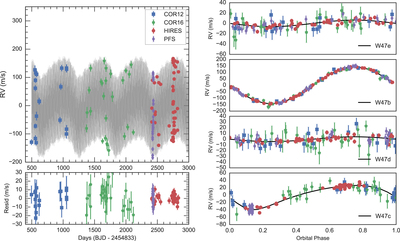Image Details

Caption: Figure 5.
Left, top: radial velocities of WASP-47 from four observational campaigns: CORALIE before 2012 (blue squares), CORALIE before 2016 (green pentagons), PSF (purple diamonds), and HIRES (red circles). The best-fit model to the TTVs and RVs (fine gray line) is shown. Left, bottom: RV residuals (observations minus the TTVFaster+radvel model values). The rms of the residuals is 8.5 ﹩{\rm{m}}\,{{\rm{s}}}^{-1}﹩, which is comparable to the mean jitter-enhanced RV uncertainty over all the telescopes (7.7 ﹩{\rm{m}}\,{{\rm{s}}}^{-1}﹩). Right: the RVs phase-folded to the orbital periods of planet e (top), b (second from top), d (second from bottom), and c (bottom). The HIRES RVs are the only single data set that constrain the semi-amplitudes of all the planets, because they have the precision (3 ﹩{\rm{m}}\,{{\rm{s}}}^{-1}﹩) to capture the small amplitudes of planets e and d, and also the baseline to capture the amplitude of the long-period planet c.
Copyright and Terms & Conditions
© 2017. The American Astronomical Society. All rights reserved.












